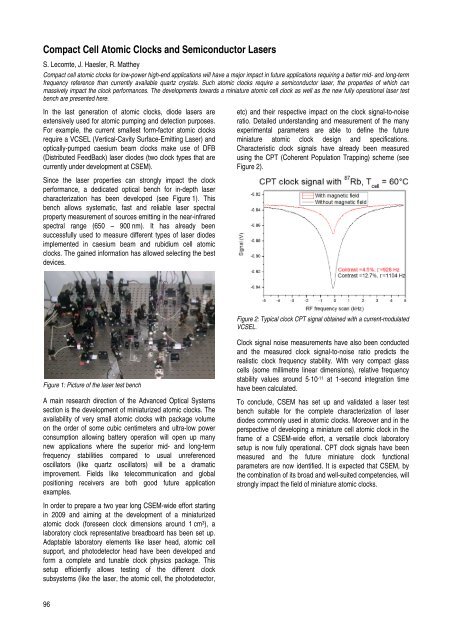CSEM Scientific and Technical Report 2008
CSEM Scientific and Technical Report 2008
CSEM Scientific and Technical Report 2008
You also want an ePaper? Increase the reach of your titles
YUMPU automatically turns print PDFs into web optimized ePapers that Google loves.
Compact Cell Atomic Clocks <strong>and</strong> Semiconductor Lasers<br />
S. Lecomte, J. Haesler, R. Matthey<br />
Compact cell atomic clocks for low-power high-end applications will have a major impact in future applications requiring a better mid- <strong>and</strong> long-term<br />
frequency reference than currently available quartz crystals. Such atomic clocks require a semiconductor laser, the properties of which can<br />
massively impact the clock performances. The developments towards a miniature atomic cell clock as well as the new fully operational laser test<br />
bench are presented here.<br />
In the last generation of atomic clocks, diode lasers are<br />
extensively used for atomic pumping <strong>and</strong> detection purposes.<br />
For example, the current smallest form-factor atomic clocks<br />
require a VCSEL (Vertical-Cavity Surface-Emitting Laser) <strong>and</strong><br />
optically-pumped caesium beam clocks make use of DFB<br />
(Distributed FeedBack) laser diodes (two clock types that are<br />
currently under development at <strong>CSEM</strong>).<br />
Since the laser properties can strongly impact the clock<br />
performance, a dedicated optical bench for in-depth laser<br />
characterization has been developed (see Figure 1). This<br />
bench allows systematic, fast <strong>and</strong> reliable laser spectral<br />
property measurement of sources emitting in the near-infrared<br />
spectral range (650 – 900 nm). It has already been<br />
successfully used to measure different types of laser diodes<br />
implemented in caesium beam <strong>and</strong> rubidium cell atomic<br />
clocks. The gained information has allowed selecting the best<br />
devices.<br />
Figure 1: Picture of the laser test bench<br />
A main research direction of the Advanced Optical Systems<br />
section is the development of miniaturized atomic clocks. The<br />
availability of very small atomic clocks with package volume<br />
on the order of some cubic centimeters <strong>and</strong> ultra-low power<br />
consumption allowing battery operation will open up many<br />
new applications where the superior mid- <strong>and</strong> long-term<br />
frequency stabilities compared to usual unreferenced<br />
oscillators (like quartz oscillators) will be a dramatic<br />
improvement. Fields like telecommunication <strong>and</strong> global<br />
positioning receivers are both good future application<br />
examples.<br />
In order to prepare a two year long <strong>CSEM</strong>-wide effort starting<br />
in 2009 <strong>and</strong> aiming at the development of a miniaturized<br />
atomic clock (foreseen clock dimensions around 1 cm3 ), a<br />
laboratory clock representative breadboard has been set up.<br />
Adaptable laboratory elements like laser head, atomic cell<br />
support, <strong>and</strong> photodetector head have been developed <strong>and</strong><br />
form a complete <strong>and</strong> tunable clock physics package. This<br />
setup efficiently allows testing of the different clock<br />
subsystems (like the laser, the atomic cell, the photodetector,<br />
96<br />
etc) <strong>and</strong> their respective impact on the clock signal-to-noise<br />
ratio. Detailed underst<strong>and</strong>ing <strong>and</strong> measurement of the many<br />
experimental parameters are able to define the future<br />
miniature atomic clock design <strong>and</strong> specifications.<br />
Characteristic clock signals have already been measured<br />
using the CPT (Coherent Population Trapping) scheme (see<br />
Figure 2).<br />
Figure 2: Typical clock CPT signal obtained with a current-modulated<br />
VCSEL.<br />
Clock signal noise measurements have also been conducted<br />
<strong>and</strong> the measured clock signal-to-noise ratio predicts the<br />
realistic clock frequency stability. With very compact glass<br />
cells (some millimetre linear dimensions), relative frequency<br />
stability values around 5⋅10 -11 at 1-second integration time<br />
have been calculated.<br />
To conclude, <strong>CSEM</strong> has set up <strong>and</strong> validated a laser test<br />
bench suitable for the complete characterization of laser<br />
diodes commonly used in atomic clocks. Moreover <strong>and</strong> in the<br />
perspective of developing a miniature cell atomic clock in the<br />
frame of a <strong>CSEM</strong>-wide effort, a versatile clock laboratory<br />
setup is now fully operational. CPT clock signals have been<br />
measured <strong>and</strong> the future miniature clock functional<br />
parameters are now identified. It is expected that <strong>CSEM</strong>, by<br />
the combination of its broad <strong>and</strong> well-suited competencies, will<br />
strongly impact the field of miniature atomic clocks.








